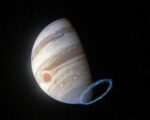James Webb Telescope Detects First Signs of Einstein Zig-Zag Effect in a Remote Quasar

A groundbreaking study leveraging data from the James Webb Space Telescope (JWST) has unveiled a rare cosmic phenomenon termed the “Einstein zig-zag.” This effect occurs when light from a distant quasar travels through two distinct warped regions of space-time, producing multiple mirrored images. Researchers identified six duplicates of a luminous quasar, J1721+8842, providing unprecedented insights into the dynamics of gravitational lensing and offering potential solutions to long-standing questions in cosmology.
The Discovery of a Complex Quasar Configuration
Quasar J1721+8842 was first observed in 2018, appearing as four distinct mirrored points of light situated billions of light-years away. These images were attributed to gravitational lensing, a phenomenon where light from a far-off celestial object bends due to the immense gravity of an intervening galaxy. However, further observations in 2022 revealed two additional, fainter points of light, hinting at a more intricate gravitational lensing scenario involving multiple massive objects.
JWST Sheds New Light on the Phenomenon
With the high-resolution capabilities of the JWST, researchers reanalyzed the data and confirmed that all six images originated from the same quasar. As detailed in a recent study published on arXiv, the quasar’s light was bent by two massive lensing galaxies in a complex manner, forming not only the mirrored images but also a faint Einstein ring. The unique configuration, where the light traveled in opposing directions around the lenses, inspired the term “Einstein zig-zag” to describe the observed effect.
Implications for Cosmology and Gravitational Lensing
This discovery holds profound implications for the study of gravitational lensing and the structure of the universe. By analyzing the “Einstein zig-zag,” scientists can better understand the distribution of dark matter in lensing galaxies and refine models of cosmic evolution. Additionally, the intricate lensing system offers an invaluable tool for probing the nature of quasar light and testing general relativity under extreme cosmic conditions. As researchers continue to explore such phenomena with JWST, new opportunities to unlock the mysteries of the universe are emerging.





















